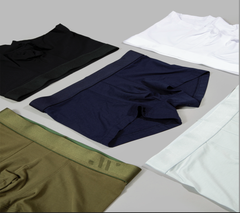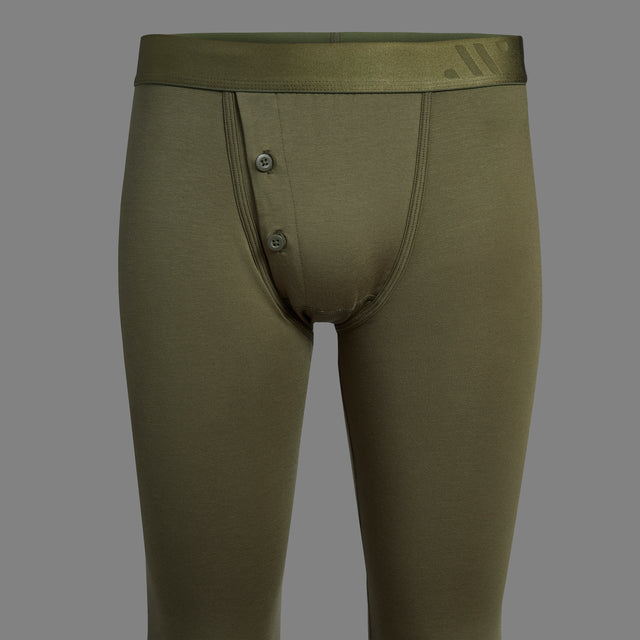Top 4 Fabrics to Make Men’s Underwear
The Top 4 Fabrics Used to Make Men’s Underwear

Underwear has been around since Adam and Eve first donned fig leaves in the Garden of Eden. And no matter how styles have evolved over the millennia, men have been looking for comfortable materials to use for underwear ever since. Our earliest ancestors used leaves and animal skins. The ancient Egyptians, Greeks, and Romans used linen made from the flax plant, and Europeans in the Middle Ages turned to wool and cotton. And today, we have even more fabric choices for underwear. In this article, I’ll discuss the top four fabrics found in men’s underwear today. I will examine the pros and cons of each, and how we ultimately made the choice we did for ALPHX.
The Role of Fabric in Comfort
When it comes to how guys define “comfortable underwear,” we didn’t want to assume anything. So we spoke with a large number of men over several months. We asked them to describe what made underwear comfortable for them. The question was open-ended. They could answer in any way they chose. And while the men differed in age, size, race, ethnicity, and sexual orientation, their responses were very similar. For example, the most common words the group used were:
“soft, lightweight, breathable, cotton, and natural”
in addition to agreeing on what characteristics they found comfortable in underwear, they largely agreed on what made underwear uncomfortable.
“Stretching-out, riding-up, wedgies, material that made them hot, waistband pinching, uncomfortable tags, and poor quality ”
In short, men used qualities associated with fabric to define comfort, and negative experiences resulting from both fabric and design details were given as examples of what made underwear uncomfortable.
The fabric was the most significant factor for these men in comfortable underwear. Of course, design details could worsen the experience, but it was hard to see how design alone could overcome uncomfortable fabric.
Based upon the data collected from these men and additional research, we realized that for ALPHX to create the most comfortable boxer briefs, trunks, and briefs, our underwear would need to be,
Soft, breathable, made from lightweight cotton or natural material, with no uncomfortable tags, and did not ride up, cause wedgies, pinch or fall apart after a few wearings.
No problem, right?
The Top Fabrics:

Cotton, polyester, modal, and nylon are the top four fabrics used in making men’s underwear today. Together they account for 97% of the sales in the category. As you will see, each of these fabrics has unique qualities that make it easy to understand why they are popular. But they each have their own drawbacks that need to be considered, too.
#4. Nylon

Coming in at number four, nylon represents 4% of the market. It was first introduced in 1935 as a silk alternative for stockings, thereafter referred to as nylons. nylon , also known as polyamide, is a petroleum-based fabric like its cousin polyester .
Pros
Nylon , like polyester , resists wrinkling, so underwear made from nylon will always look crisp when worn. But, since nylon was developed as a silk alternative, it feels softer against the skin than polyester . It is also shinier, stretchier, and stronger, so garments made from nylon will outlast those made from polyester .
Cons
Nylon absorbs water, so it does not have the same wicking properties as polyester . It also does not take color as well and is subject to pilling in high friction areas.
#3 Modal

At number three, we find modal , which accounts for 10% of the men ’s underwear sales in the U.S. today. It is also the fastest-growing fabrication, and for good reasons.
Pros
Modal is a type of rayon and, like cotton , is a cellulose fabric. But while cotton comes from the cotton plant, modal begins its life as a beech tree. Wait …What? It may sound hard to believe, but modal is arguably the softest fabric we are discussing. It is also lightweight, provides ventilation, and has an overall luxurious feel. Despite its weight and softness, modal is durable, shrink resistant, and takes color exceptionally well. These qualities seem to check many of the boxes guys are looking for in underwear, so it stands to reason that it would be growing in popularity.
Cons
But modal alone has a few drawbacks. While the hand-feel is luxurious modal alone can be considered too “slinky ”for some. It can also pill (like a cashmere sweater), particularly between the thighs or other friction points over time.
#2 Polyester

Polyester occupies the number two spot, and represents 15% of all underwear sold in the U.S. And despite what you may be thinking ,polyester has come a long way since the leisure suits of the 70s and is definitely worth discussing.
Pros
Polyester has many positive attributes: It is less absorbent than cotton or modal . In fact, it is considered a hydrophobic material that draws moisture away from the body to the surface of the fabric, where it evaporates. In addition, polyester resists shrinking, is durable, and it can be printed with greater clarity and vibrancy than either nylon or cotton . These qualities make polyester a terrific choice for performance underwear or for brands focused on intricate prints with many details.
Cons
The drawback to polyester is that while the fabric contains some mechanical stretch, polyester alone will not move with your body, leading to ride-up. In addition, while it wicks moisture, it is not as breathable as some other fabrics we are discussing. Polyester is also less soft to the touch than its cousin, nylon . That said, advancements continue to be made, improving the overall feel of polyester fabrics.
#1 Cotton

This brings us to the number one fabric used for men ’s underwear today: cotton . Despite the growth of polyester and modal , cotton is still king in men ’s underwear and makes up 68% of sales in the U.S. today.
Pros
It ’s easy to understand why this is the case. Cotton has remained the fabric of choice since 500 CE. It is soft, lightweight, and breathable. It ’s also durable, holding up well to detergents and heat, making it an economical choice for underwear.
Cons
Sounds like we have a winner, right? Well, not quite. Cotton alone has drawbacks: 100% cotton can shrink by as much as 20% when laundered, and body heat causes cotton fibers to loosen and stretch out, leading to ride-up, bunching, and, God forbid, wedgies. Cotton also comes in different quality grades and finishes, which affect the ultimate feel, breathability, and durability of the garments.
Honorable Mention: Elastane
Elastane is a synthetic fabric known for its elasticity. It was invented in 1958, by DuPont, and people have been grateful ever since. Elastane is probably better known as Lycra which is a brand name, or Spandex which is an anagram for the word “expand,”because of its stretch and recovery properties.(https://www.treehugger.com/what-is-elastane-and-is-it-sustainable-5116805 )
Why Choose Just One?
So there you have it. The top four fabrics used in men ’s underwear are:
- Cotton
- Polyester
- Modal
- Nylon
We wanted to make ALPHX your go-to underwear: comfortable for work, going out, or just hanging out at home with friends. So, we reviewed our consumer wish list against the top four options.
Comfortable underwear must be soft, breathable , made from lightweight cotton or natural material , with no uncomfortable tags. It must not ride up , cause wedgies, pinch, or fall apart after a few wears.

It was clear that no one fabric checked all of the boxes. Fortunately, we did not have to choose just one material for ALPHX. Fibers can be blended before spinning to create yarns that maximize the best qualities of each individual fabric while offsetting their shortfalls. Once the threads have been integrated and spun into yarn, they are knitted or woven into garments.
Think of combining materials as creating an alloy of sorts. For example, pure gold is too soft to make jewelry. Adding metals like iron or silver to gold creates a beautiful and strong material, perfect for making jewelry.
Alphx
We started with all-natural cotton for softness and breathability, choosing lightweight cotton jersey for enhanced ventilation and comfort. Next, we added tree-based modal for its luxurious hand feel, durability, and color fastness. Finally, for stretch and recovery, we used elastane, which allows our underwear to move with you without stretching out or riding up. We will revisit polyester and nylon for a later collection, one targeted explicitly for performance.

We love our Everyday Comfort Fabric, containing 56% cotton, 38% modal, and 6% elastane, but perhaps we’re biased. To ensure you will too, we went through an extensive testing process with consumers. We sent samples in various sizes to men of different ages and body types. We asked them for feedback after wearing the underwear, laundering them, and wearing them again. The feedback was incredibly beneficial, and the response was overwhelmingly positive. We even tested ALPHX in workout settings, including yoga and strength training. Again, the underwear performed exceptionally well. No matter how many stretches, lunges, or squats were completed, we received no reports of ride-ups, wedgies, or pinching. (PS: no sweaty swamp-butt either! ).

Take Aways:
Hopefully, this article has explained the following:
- Men want comfortable underwear.
- Fabric is critical to overall comfort.
- Cotton, Polyester, Modal, and Nylon are the top four fabrics used today for underwear.
- Each has its pros and cons
- Fabrics can be blended
- Alphx chose to blend Cotton, Modal, and Elastane, to best achieve the comfort criteria set out by our consumers.
While fabric is key to comfort, design details play a role as well. I will point out how we enhance our comfortable fabric with gimmick-free design solutions in a future post.
In the meantime, I invite you to give Alphx a try for yourself. Use the code Giveusatry15 to receive 15% off your first purchase at http://www.alphx.com .






0 Comments
There are no comments for this article. Be the first one to leave a message!